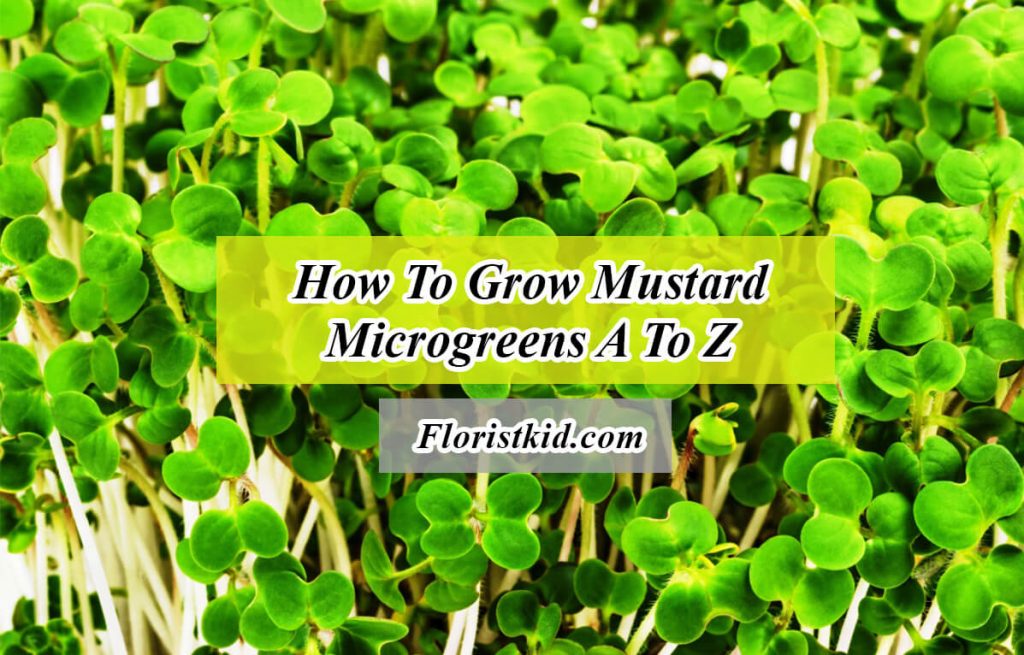Microgreens from the mustard family are vibrant, healthy, and simple to grow. Mustard is a fantastic addition to any Asian-inspired dish. Its germination and yield consistency make it a valuable addition to any growing list. There are numerous mustard types to pick from, each with its unique appearance.
The tooth-shaped leaves of Mizuna, Crimson Tide, and Ruby Streaks are some of those varsities which have varying colors. The leaves of Garnet Red and Red Giant are other ones with spherical having contrasting colors. Mustard microgreens come in a wide range of colors, from green to deep purple, making them a very versatile crop. They have a mild to spicy flavor and are pretty delicious.
If Like to know more about microgreens, check these articles:
<<What Are Microgreens >> and <<Best Microgreens For Smoothies>>
Mustard’s Origins
Mustard has a five-thousand-year history and is known for its spicy nature. It is one of the few plants that has been grown for both seeds and leaves. Mustard as a condiment evolved from a paste produced by the Greeks. Mustard has therapeutic properties in addition to its strong flavor. It was claimed to relieve scorpion stings and be used to treat a variety of diseases. The mustard leaf has been used in cooking for centuries, from China to the United States. It is still popular due to its flavor and nutritional content.
Mustard microgreen in dishes
Mustards flavor intensifies with aging. The popular condiment is made from the seeds of mature mustard plants, which explains the strong, peppery flavor found in their leaves. Some chefs believe that its taste is similar to horseradish.
Mustard variations have red or green leaves and upright white stems. Their spicy flavor makes them a perfect addition to Asian salads and stir-fries. Meat, poultry, and seafood recipes benefit from micro-Mustard. A classic combo for sandwiches is mustard and cress microgreens. This is one microgreen combinat that you should add to your crop list for various reasons. Like other hot, spicy greens, Mustard microgreens boasts a long list of health advantages. It is a good defense against colon and bladder cancer since it is high in antioxidants.
Mustard microgreens overview
| Family | Brassicaceae |
| Recommended Varieties | Red Giant, Ruby Streaks, Garnet Red, Mizuna, Crimson Tide and Ruby Streaks |
| Nutrition | Vitamin A, Vitamin C, Vitamin E, Vitamin K, Folate, Calcium, iron, and zinc |
| Average days to germinate | 3 to 4 days |
| Average days to harvest (after germination) | 7 to 11 days |
| Difficulty | Easy |
Micro mustard Nutrition
Mustard microgreens are no exception to the rule that microgreens are abundant in vitamins. Microgreens have a higher nutritional content than their mature counterparts. This could be because they are harvested so soon after germination that they have not lost any nutrition they would have used to grow into mature plants. Vitamin A, Vitamin C, Vitamin E, Vitamin K, Folate, Calcium, iron, and zinc are some of the vitamins and minerals found in mustard microgreens.
 How to grow mustard microgreens
How to grow mustard microgreens
To start growing mustard microgreens at home, you will need the following items:
- A container or tray with holes at the bottom
- A second tray to be placed beneath the first to catch excess water
- A potting sterile soil mix containing around 80% peat moss and 20% perlite
- Mustard microgreens seeds
- Bottle for spraying water
After you have prepared all of the necessary equipment, you can begin the growth process as follows:
Prepare The Tray
Fill a shallow tray or container with the sterile soil mix in any shallow tray or container with drainage holes. Place a second tray beneath the growth tray to catch any spilled water. This will safeguard your countertop or any other surface where the microgreen tray is placed.
mustard microgreens seeds
Spread the Seeds
When growing microgreens, you may usually sow all of the seeds close together, giving the microgreens a “carpet-like” appearance as they mature. Simply spreading the seeds over the soil and lightly pushing them into the soil will suffice.
After that, lightly mist your seed tray. Mustard microgreens should be kept moist until they germinate, but not so wet that the seeds drown.
Lightening
Place your seed tray on a sunny windowsill or beneath a grow light for 8-10 hours every day.
Monitoring
After three days, mustard microgreens seeds germinate. They will only take one or two weeks to grow after that. Every day, test the moisture in the soil with your fingers. You do not let your seeds resting in a puddle, so make sure the soil is not too wet. You can use the spray bottle to water your greens until they start to take root.
Once the microgreens have begun to grow, you can start watering them from the bottom to avoid overwatering and also toppling over. To accomplish this task, pour some water into the second tray.
Harvesting Your Greens
You can harvest your mustard microgreens by cutting them off just above the soil level. You may then store them in the fridge for up to a week between moist paper towels in a bag or container.
Conclusion
In a nutshell, Mustard has a five-thousand-year history. It’s one of the few plants that has been grown for both seed and leaves. Mustards are a popular microgreen because they quickly germinate, sprouting in 3 to 4 days and producing large yields in 10 to 12 days. The wait for the baby leaves is roughly 20 days. Mustard microgreen is substantially more nutrient-dense than its mature plant. This could be because they are harvested so quickly after they have germinated. Vitamin A, Vitamin C, Vitamin E, Vitamin K, Folate, Calcium, iron, and zinc are among the vitamins and minerals found in this attractive microgreen.



 How to grow mustard microgreens
How to grow mustard microgreens




